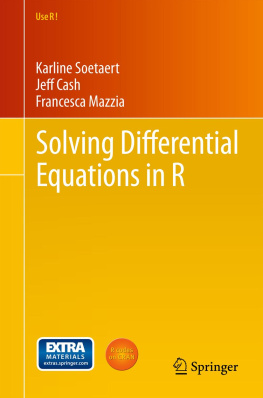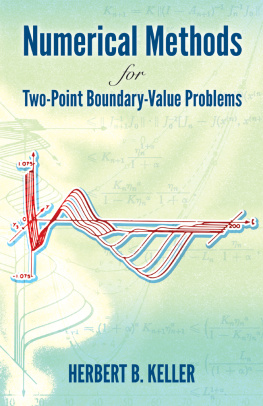All rights reserved. No part of this book may be reproduced in any form by any electronic or mechanical means (including photocopying, recording, or information storage and retrieval) without permission in writing from the publisher.
Names: Miao, Jianjun, 1969- author.
Title: Economic dynamics in discrete time / Jianjun Miao.
Description: Second Edition. | Cambridge, MA: MIT Press, [2019] | Revised edition of the authors Economic dynamics in discrete time, [2014] | Includes bibliographical references and index.
Identifiers: LCCN 2019020120 | ISBN 9780262043625 (hardcover: alk. paper)
Subjects: LCSH: Econometric models. | Economics--Mathematical models. | Statics and dynamics (Social sciences) | Discrete-time systems.
Contents
List of Figures
Cobweb diagram for the system xt+1 = 2xt(1 xt)
Impact of dividend taxes on the stock price
Nullclines: The left and right panels plot the isoclines xt = 0 and yt = 0, respectively
Phase diagram
Phase diagram for example 1.5.1
Cobweb diagrams for the three dynamical systems f(x) = x + x3, g(x) = xx3, and h(x) = x + x2
Saddle-node bifurcation for the map f(x; a) = x2 + a
Transcritical bifurcation for the map f(x; a) = ax(1 x)
Pitchfork bifurcation for the map f(x; a) = axx3
Period-doubling bifurcation for the map f(x; a) = x2 + a
Bifurcation diagram for the logistic system f(x) = ax(1 x)
Cobweb diagram and the orbit starting at x0 = 0.3 for the logistic system f(x) = 4x(1 x)
The tent map f(x) and its iterates f2(x) and f3(x) on [0, 1]
Logistic function f(x) = 4x(1 x) and its third iterate f3(x)
Transitional dynamics in response to a temporary technology shock
Graphic representation of a Markov chain
Graphic representation of the birthdeath Markov chain
Graphic representation of the unrestricted one-dimensional random walk
Option value. Plotted is the value function V(z) for the irreversible project investment problem.
Value function. Plotted is the value function V(s) for the discrete choice problem.
The determination of the saving function and its properties
Policy functions. Plotted are consumption and assets as functions of cash on hand.
Evolution of cash on hand. Plotted is xt+1 as a function of xt for the largest and the lowest income levels.
Optimality of the (s, S) policy. Illustrated is the solution for the one-period problem.
Minimization of Gn(x)
Reward to investing. Plotted is the function (Q, K) for a fixed value of K in the case without fixed costs.
Three regions of states for (K, z). Plotted are the two boundaries that partition the state space into the buy region, sell region, and inaction region in the case without fixed costs.
Reward to investing. Plotted is the function (Q, K) for a fixed value of K in the presence of fixed costs.
Chebychev polynomial basis functions up to nine degrees on the unit interval
Linear B-splines with nine equally spaced breakpoints {0, 1/8, 1/4, 3/8, 1/2, 5/8, 3/4, 7/8, 1}
Cubic B-splines with seven equally spaced breakpoints {0, 1/6, 1/3, 1/2, 2/3, 5/6, 1}
Phase diagram for the log-linearized basic RBC model
Labor market equilibrium for the log-linearized basic RBC model
Phase diagram after a permanent TFP shock for the log-linearized basic RBC model
Labor market responses following a permanent TFP shock for the log-linearized basic RBC model
Comparison of impulse responses to a TFP shock with different levels of persistence
Comparison of impulse responses to a TFP shock with different levels of persistence
Comparison of impulse responses to a TFP shock for different values of the risk aversion parameter
Comparison of impulse responses to a TFP shock for different values of the Frisch elasticity of labor supply
Comparison of impulse responses to a TFP shock for different values of the habit formation parameter
Impulse responses to a permanent TFP shock
Impulse responses to a TFP shock and an investment-specific technology (IST) shock
Impulse responses to a government-spending shock at different levels of persistence
Impulse responses to a preference shock at different levels of persistence
Priors and posteriors
Offer curve
One stable nonmonetary steady state and one unstable monetary steady state
Locally stable monetary steady state
Two-period cycle equilibrium
Feasibility and budget lines
Three positive steady states and G(0) > 1
Two positive steady states and G(0) < 1
Zero positive steady state and G(0) < 1
Indeterminancy
Unique positive and stable steady state
Locus kt = kt+1kt = 0 and vector fields
Locus bt = bt+1bt = 0 and vector fields
Phase diagram. The bubbly steady state is (kg, b*). It is a saddle point. The Diamond bubbleless steady state is (kD, 0). There are infinitely many equilibria converging to the Diamond steady state.
Determination of equilibrium in Aiyagaris (1994) model. The intersection of the Ea(r) curve and the FK curve gives the equilibrium interest rate and the capital stock.
Determination of equilibrium in Aiyagaris model in example 18.1.1
Determination of equilibrium in Huggetts (1993) model
Two stationary equilibrium rates of return on currency that finance the constant government deficit G
Steady-state equilibrium market tightness and wage
Steady-state equilibrium vacancies and unemployment
Phase diagram
Adjustments of vacancies and unemployment
Equilibrium reservation productivity and market tightness
Effect of higher productivity on equilibrium vacancies and unemployment
Impulse responses to a positive 1 percent shock to monetary policy
Impulse responses to a positive 1 percent shock to the natural rate
Impulse responses under optimal commitment and discretionary policies
L as a function of L
Derivatives of YL with respect to the values of rL and GL, for alternate degrees of persistence of the financial disturbance
Fiscal multiplier as a function of





